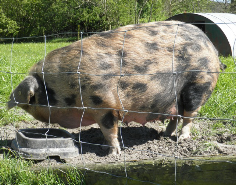How long do pigs live?
The oldest working breeding pig on the farm is 8 years old. I have had an exception, a Grand Duke Boar who worked until he was 9 years old. So it is worth investing in an excellent pig as it will be with you for years.
How many litters does a sow have a year?
Usually two litters as the gestation period is 3 months 3 weeks and 3 days, from service to farrowing.
When should I wean a litter?
This is totally dependant on the size of the litter and how the sow is milking them. Young gilts will probably need weaning at 6 weeks, while a big old sow will stand to go 8 or 9 weeks. The last few weeks of the sow’s lactation are the most taxing on the sow and the piglets should be offered an ad lib creep feed from 3 weeks of age. I usually wean on sow condition, as this is the only time in a sows breeding cycle you have the opportunity to get fat off her back. Weight drops off during the last week of lactation as the litter pull hard at her milk.
At weaning should I move the sow or litter?
I always move the sow to the boar and leave the litter in the same pen for several days. I find the litter have no set backs at weaning as they are totally familiar with their surroundings, feed and water supply.
How do you dry the sow off?
I don’t dry the sow. The sow at weaning goes directly into a boar, who is usually running with dry sows. This introduction stimulates ovulation, which usually takes 3-5 days after weaning. The sow’s milk dries very quickly. It is important to watch that the newly weaned sow is not too daunted by the other sows and still gets sufficient food. Some degree of social scrapping is to be expected for 24 hours or so but this actually helps bring the sow into season.
Do I need a farrowing crate?
Saddlebacks love space and hate being confined. My best results are obtained by turning a small bale of straw into the farrowing area several days before farrowing. Let the sow nest and leave well alone.
Do I need to be there for farrowing?
Personally I now leave the sows to farrow alone. I find the stress of a human in the vicinity can cause more problems than intervention can save the odd piglet. BEWARE even the most placid sow may become somewhat more aggressive at, during and immediately after farrowing. It is a totally natural reaction for a sow to protect her brood.
Do I have to feed the sow more when she has farrowed?
No, she should be kept on the same pre farrowing amount of food for 2 or 3 days and then gradually increasing by half a kilo per day. By 28 days after farrowing with a litter of 10 piglets the sow should be consuming about 10 kilos of food. More piglets more food – less piglets less food. Buy the best food you can buy as this will go into the piglets and give them the best start with lots of milk.
Is it ok to farrow outside?
Saddlebacks will farrow wherever you put them – outside farrowed piglets are often the most healthy. I like to give the new born piglets when inside some sods to chew on as there are things in the soil whish seem to help their vigour and health.
Why buy pedigree pigs?
Saddleback pigs are still a rare breed and endangered. Some female and boar lines still have less than 5 registered pigs. By breeding pedigree and registered pigs you are helping to preserve one of the greatest pigs. A pig without a pedigree is just another pig. All pigs in the Coal Yeat Saddleback herd are pure pedigree pigs and all the litters are birth notified with the BPA
Do I need a licence to move pigs?
Yes but I have lots here and will complete them on the sale of the pigs. All you have to do is send the white copy into Trading Standards when you get the pigs home. (Must be sent within three days of arrival)
How large is your breeding pool? Are the gilts and boar totally unrelated?
The Coal Yeat herd has 10 female lines and 5 boar lines to enable totally unrelated male and females to be bred within the Coal Yeat herd. We have over 25 breeding females. Selection of pure bred pigs is very severe, only approx 10%of all the pigs are registered for as breeding pigs.
Why do you keep Saddleback pigs?
I keep British Saddleback pigs because I like them and they always do well for me! I supply 3 butchers on a regular weekly basis, with up to 12 pigs a week. To enable a continuity of supply I need at least 25 breeding Saddleback females.
I have a wood, will the pigs be ok in there?
Yes, woodland is I believe the natural habitat of pigs. As long as your Saddleback pigs have a shelter, food and water they will be in their element. The shade will be especially helpful in summer.
Can I bring a sow or gilt back to be served?
I am very protective of the Coal Yeat Herds health status. Sows and gilts will only be accommodated as long as you have no other pigs on your holding, that have not originated from the Coal Yeat herd as a direct sale from myself. I always suggest they stay for 6 weeks to cover two possible “brimming” heats. This is charged at £7 / week B&B and £10 for the boars pleasure.
Where does the pig need to sleep? How big?
A pig ark is the traditional pig house but anywhere dry will suffice. I’m always amazed how many sows can lie together in a relatively small ark, they like cuddling!
Are Saddleback pigs suitable for children?
Yes, both my grandchildren have supervised access to the British Saddleback pigs (one 6 one 9 years old).They enjoy the tactile appreciation of the pig to T.L.C! Both Harry and Imogen love showing the pigs in the young handlers classes. Saddleback pigs are like any other animal and need to be treated with the respect they deserve.
How many times do I feed the pig?
Young British Saddleback pigs are on creep feed and therefore have access to food 24/7. Usually when 5 or 6 months old they are ready for the butcher or are put onto a once a day feeding. All adult British Saddleback pigs on my farm are fed once a day with sow nuts. The boars and the gilts/sows eat the same food but many breeders feed twice a day.
Are your British Saddleback pigs registered with BPA?
The British Pig Association registers all breeds of British pigs (except Lops). Initially each litter is birth notified then pigs are selected for individual registration. All breeding pigs in the Coal Yeat Herd are pure pedigree registered British Saddleback pigs. Only ‘growers’ sold for fattening are sold off the farm as unregistered.
What are the pigs eating? Will you sell me the same food?
All the adult pigs eat BOCM sow rolls a 15% protein mix. All the growing pigs eat a ‘grow lean’ pencil which is 18% protein. All pigs sold from the farm have a complimentary bag of food for sales over£300.00.How old are the piglets when they are weaned? Usually mature sows are weaned at 8 weeks old. Gilts with their first litters may be weaned earlier if the litter is starting to drag the gilt down. Sometimes sows and gilts give so much of themselves to their litters that they become too thin.
How long have they run with the boar? Is he registered?
The breeding cycle for female British Saddleback pigs is 3 weeks “heat to “heat”. From service to farrowing is 3 months, 3 weeks and 3 days. Sows at weaning usually take the boar 5-7 days after weaning. All Saddleback sows in the Coal Yeat Herd are put straight to the boar at weaning. Therefore two litters a year is the norm. All boars are pure registered British Saddleback pigs.
Have the pigs run outside?
This is entirely dependent on the time of year and the weather. The mature boars and sows run outside most of the year. Saddleback sows freely farrow outside in the individual arks in the spring, summer and autumn. I try to get the young stock outside in the fields during summer but most of the winter time they are housed in yards under ‘Dutch barns’. Very open to the air but sheltered from rain and snow.
Do the pigs know what an electric fence is?
I use an electric fence outside to paddock graze the Saddleback pigs. So many of the adult Saddleback pigs are very alert to electric fencing. Young pigs, however, will probably not have experienced their first ‘twang’ as they are kept in smaller fenced paddocks.
Can you show me other pigs that are not for sale, perhaps the pig’s dam and sire?
Time permitting; all my pigs are permanently available for viewing. My farm is however split over 3 sites 2 miles apart, so it may not be possible to fit in all the Saddleback pigs.
How long will I have to keep them before killing them?
I usually send the British Saddleback pigs to the butcher at 5-6 months old. This is totally dependent on how much food they get, the quality and the pigs environment. Active pigs reared outside will grow slower and slimmer than sleepy pigs inside, in the warmth of their den. Fat cover of the carcass is totally dependent on the type of food and Saddleback pigs environment.
What do I need to move pigs?
All pigs need a licence to move on and off a holding. The licence on arrival of the new holding has to be sent to the local trading standards office within 3 days. I have licences on my farm. The licence needs a holding number, which if you do not have one is available from R.P.A. (D.E.F.R.A)
Do I need to bring my holding number?
Yes please as the licence has to have on it on. If you have not got one it is possible to move pigs onto your holding as long as you are applying for one.
Will the pigs fit in a box in the back of my car?
NO! As they will eat their way out and make a smelly mess on your seats. A trailer, covered pickup or wagon is needed, even for the smallest pigs.
Can you arrange delivery in the UK?
Yes we have delivered Saddleback pigs to as far away as the South Coast, Scotland and Cornwall. We do charge for this service, or for large orders we can arrange for livestock hauliers to collect the pigs – at your expense. Here at the Coal Yeat Herd of pedigree British Saddleback pigs we go out of our way to ensure the right pigs find the right homes.





